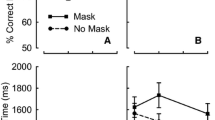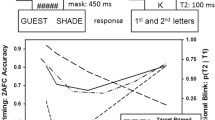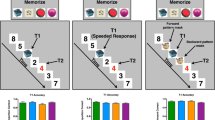Abstract
The overinvestment account of the attentional blink (AB) posits that the AB results from the allocation of more resources than necessary to encode a first target (T1), which in turn lowers the resources available to encode a second target (T2) shortly thereafter. Across two experiments, we examined whether resource allocation to T1, and thus overinvestment that results in an AB effect, might be limited by perceptual mechanisms that evaluate the need for encoding resources. The key result observed in both experiments was that a relatively easy to encode T1 can nonetheless result in an AB when it is perceptually similar to a more difficult to encode T1. The importance of experimental context as an influence on the allocation, or overinvestment, of attentional resources to T1 is highlighted by these findings.



Similar content being viewed by others
Notes
A mixed factor ANOVA was also conducted on mean T2 performance for row-of-X trials only, for the 75% two-word block in Experiment 1 and the mixed block in Experiment 2. This analysis treated experiment as a between-subjects factor and SOA (233/467/700 ms) as a within-subject factor. The analysis revealed a significant main effect of SOA, F (2,72) = 7.5, p = .001, \( \eta_{\text{p}}^{2} \) = .17, that was moderated by a significant experiment by SOA interaction, F (2,72) = 13.6, p < .001, \( \eta_{\text{p}}^{2} \) = .27. Subsequent analyses revealed an effect of experiment at the middle SOA only, F (1,36) = 6.9, p = .01, \( \eta_{\text{p}}^{2} \) = .16. Performance for row-of-X trials was significantly less accurate at this SOA in the mixed context of Experiment 2 (.73) than in the 75% selection context of Experiment 1(.94). However, the effect of experiment approached significance at the 233 ms SOA. Here, performance for row-of-X trials was slightly more accurate at this SOA in the mixed context of Experiment 2 (.93) than in the 75% selection context of Experiment 1(.87; p = 1).
References
Akyürek, E. G., Toffanin, P., & Hommel, B. (2008). Adaptive control of event integration. Journal of Experimental Psychology: Human Perception and Performance, 34, 569–577.
Arend, I., Johnston, S., & Shapiro, K. (2006). Task-irrelevant visual motion and flicker attenuate the attentional blink. Psychonomic Bulletin & Review, 13, 600–607.
Awh, E., Sgarlata, A. M., & Kliestik, J. (2005). Resolving visual interference during covert spatial orienting: Online attentional control through static records of prior visual experience. Journal of Experimental Psychology: General, 134, 192–206.
Braver, T. S. (2012). The variable nature of cognitive control: a dual mechanisms framework. Trends in Cognitive Sciences, 16, 106–113.
Braver, T. S., Gray, J. R., & Burgess, G. C. (2007). Explaining the many varieties of working memory variation: Dual mechanisms of cognitive control. In: Conway, A., et al. (Ed.), Variation in Working Memory, (pp. 76–106). Oxford: Oxford University Press.
Broadbent, D. E., & Broadbent, M. H. P. (1987). From detection to identification: Response to multiple targets in rapid serial visual presentation. Perception & Psychophysics, 42, 105–113.
Bugg, J. M., & Crump, M. J. (2012). In support of a distinction between voluntary and stimulus-driven control: A review of the literature on proportion congruent effects. Frontiers in Psychology, 3, 367.
Chun, M. M., & Jiang, Y. (1998). Contextual cueing: implicit learning and memory of visual context guides spatial attention. Cognitive Psychology, 36, 28–71.
Chun, M. M., & Potter, M. C. (1995). A two-stage model for multiple target detection in rapid serial visual presentation. Journal of Experimental Psychology: Human Perception and Performance, 21, 109–127.
Colzato, L. S., Hommel, B., & Shapiro, K. (2010). Religion and the attentional blink: Depth of faith predicts depth of the blink. Frontiers in Psychology, 1, 147.
Colzato, L. S., Sellaro, R., Paccani, C. R., & Hommel, B. (2014). Attentional control in the attentional blink is modulated by odor. Attention, Perception, & Psychophysics, 76, 1510–1515.
Cousineau, D. (2005). Confidence intervals in within-subject designs: A simpler solution to Loftus and Masson’s method. Tutorials in Quantitative Methods for Psychology, 1, 42–45.
Crump, M., Gong, Z., & Milliken, B. (2006). The context specific proportion congruent Stroop effect: Location as a contextual cue. Psychonomic Bulletin & Review, 13, 316–321.
Dale, G., & Arnell, K. M. (2010). Individual differences in dispositional focus of attention predict attentional blink magnitude. Attention, Perception, & Psychophysics, 72, 602–606.
Di Lollo, V., Kawahara, J. I., Ghorashi, S. S., & Enns, J. T. (2005). The attentional blink: Resource depletion or temporary loss of control?. Psychological Research, 69(3), 191–200.
Eriksen, B. A., & Eriksen, C. W. (1974). Effects of noise letters upon the identification of a target letter in a nonsearch task. Perception & Psychophysics, 16, 143–149.
Gratton, G., Coles, G. H., & Donchin, E. (1992). Optimizing the use of information: Strategic control of activation of responses. Journal of Experimental Psychology: General, 121, 480–506.
Jolicoeur, P., & Dell’Acqua, R. (1998). The demonstration of short-term consolidation. Cognitive Psychology, 36, 138–202.
Logan, G. D., & Zbrodoff, N. J. (1979). When it helps to be misled: Facilitative effects of increasing the frequency of conflicting stimuli in a Stroop-like task. Memory & Cognition, 7, 166–174.
Lowe, D. G., & Mitterer, J. O. (1982). Selective and divided attention in a Stroop task. Canadian Journal of Psychology, 36, 684–700.
MacLellan, E., Shore, D. I., & Milliken, B. (2015). Contextual control over selective attention: Evidence from a two-target method. Psychological Research, 79, 556–569.
MacLellan, E., Shore, D.I. & Milliken, B. (2017). Sequence effects in a two target task: Intentional vs. automatic adaptations in cognitive control. (Under Review)
McLaughlin, E. N., Shore, D. I., & Klein, R. M. (2001). The attentional blink is immune to masking-induced data limits. The Quarterly Journal of Experimental Psychology: Section A, 54, 169–196.
Morey, R. D. (2008). Confidence intervals from normalized data: A correction to Cousineau (2005). Reason, 4, 61–64.
Olivers, C. N., & Meeter, M. (2008). A boost and bounce theory of temporal attention. Psychological Review, 115(4), 836.
Olivers, C. N., & Nieuwenhuis, S. (2005). The beneficial effect of concurrent task-irrelevant mental activity on temporal attention. Psychological Science, 16, 265–269.
Olivers, C. N., & Nieuwenhuis, S. (2006). The beneficial effects of additional task load, positive affect, and instruction on the attentional blink. Journal of Experimental Psychology: Human Perception and Performance, 32, 364–379.
Ouimet, C., & Jolicoeur, P. (2007). Beyond task 1 difficulty: The duration of T1 encoding modulates the attentional blink. Visual Cognition, 15, 290–304.
Raymond, J. E., Shapiro, K. L., & Arnell, K. M. (1992). Temporary suppression of visual processing in an RSVP task: An attentional blink? Journal of Experimental Psychology: Human Perception and Performance, 18, 849–860.
Schneider, W. (1988). Micro experimental laboratory: An integrated system for IBM PC compatibles. Behavior Research Methods, Instruments & Computers, 20, 206–217.
Schneider, W., & Shiffrin, R. M. (1977). Controlled and automatic human information processing: I. Detection, search, and attention. Psychological Review, 84, 1–66.
Shore, D. I., McLaughlin, E. N., & Klein, R. M. (2001). Modulation of the attentional blink by differential resource allocation. Canadian Journal of Experimental Psychology, 55, 318–324.
Stroop, J. R. (1935). Studies of interference in serial verbal reactions. Journal of Experimental Psychology, 18, 643–662.
Taatgen, N. A., Juvina, I., Schipper, M., Borst, J. P., & Martens, S. (2009). Too much control can hurt: A threaded cognition model of the attentional blink. Cognitive Psychology, 59, 1–29.
Visser, T. A. W., & Ohan, J. L. (2007). Data-limited manipulations of T1 difficulty modulate the attentional blink. Canadian Journal of Experimental Psychology, 61, 102–108.
Weichselgartner, E., & Sperling, G. (1987). Dynamics of automatic and controlled visual attention. Science, 238, 778–780.
Acknowledgements
We wish to thank Christian Olivers and one anonymous reviewer for the insightful comments on a previous version of this paper. We also wish to thank Amanda Dias for assistance with data collection.
Author information
Authors and Affiliations
Corresponding author
Ethics declarations
Funding
Financial support for this study was provided by NSERC discovery grants to BM and DIS. The authors declare no conflict of interest. All procedures performed in studies involving human participants were in accordance with the ethical standards of the McMaster Research Ethics Board (MREB). All participants provided informed consent prior to completing the study.
Rights and permissions
About this article
Cite this article
MacLellan, E., Shore, D.I. & Milliken, B. Perceptual similarity induces overinvestment in an attentional blink task. Psychological Research 82, 1091–1101 (2018). https://doi.org/10.1007/s00426-017-0889-z
Received:
Accepted:
Published:
Issue Date:
DOI: https://doi.org/10.1007/s00426-017-0889-z




